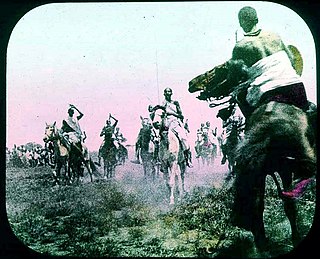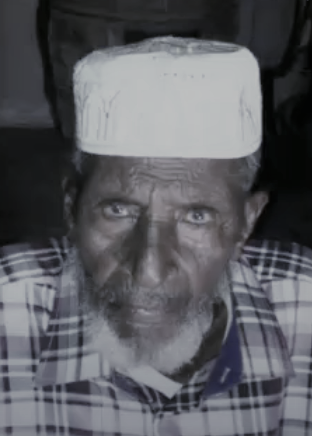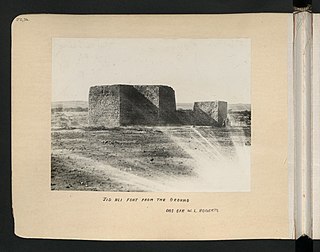The Dhulbahante is a Somali clan family, part of the Harti clan which itself belongs to the largest Somali clan-family — the Darod. They are the traditional inhabitants of the physiographic Nugaal in its topographic sense, and its pre-independence administrative sense, which included Doollo. The clan's progenitor is buried at Badweyn.
The Ogaden is one of the major Somali clans.

Muḥammad ibn 'Abdallāh Hassan was a Somali, Ultranationalist, National hero, Salihiyya, Sufi, Poet, Religious, Political, Cultural and Military leader. He founded and headed the Dervish movement, which led a Holy war against the British, Italian and Ethiopian influence in the Somali Peninsula. He is regarded as the father of the Somali people and the figure of Somali nationalism. Due to his successful completion of the Hajj to Mecca, his complete memorization of the Quran and his purported descent from the Islamic prophet Muhammad, his name is sometimes preluded with honorifics such as Hajji, Hafiz, Emir or Sayyid.

The Dervish Movement was a popular movement between 1896 and 1925, which was led by the Salihiyya Sufi Muslim poet and militant leader Mohammed Abdullah Hassan, also known as Sayyid Mohamed, who called for independence from the British and Italian colonies and the defeat of Ethiopian forces. The Dervish movement aimed to remove the British and Italian influence from the region and restore the "Sufi system of governance with Sufi education as its foundation", according to Mohamed-Rahis Hasan and Salada Robleh.

Somali nationalism is centered on uniting the Somali people who share a common language, religion, culture and ethnicity, and as such constitute a nation unto themselves. The ideology's earliest manifestations in the medieval era are traced to the Adalites whilst in the contemporary era its often traced back to SYL, the first Somali nationalist political organization to be formed was the Somali National League (SNL), established in 1935 in the former British Somaliland protectorate. In the country's northeastern, central and southern regions, the similarly-oriented Somali Youth Club (SYC) was founded in 1943 in Italian Somaliland, just prior to the trusteeship period. The SYC was later renamed the Somali Youth League (SYL) in 1947. It became the most influential political party in the early years of post-independence Somalia. The Somali guerilla militia Al-Shabab is noteworthy for incorporating Somali nationalism into its Islamist ideology.

SultanNur Ahmed Aman, was a learned religious leader and the 5th Sultan of the Habr Yunis Sultanate and later also one of the leaders behind the Somali Dervish movement and revolt (1899–1920). He was the principal agitator rallying the followers of the Kob Fardod Tariqa behind his anti-French Roman Catholic Mission campaign that would become the cause of the Dervish uprising. He assisted in assembling men and arms and hosted the revolting tribesmen in his quarter at Burao in August 1899, declaring the Dervish rebellion. He fought and led the war throughout the years 1899–1904. He and his brother Geleh Ahmed were the main signatories of the Dervish peace treaty with the British, Ethiopians and Italian colonial powers on March 5, 1905, known as the Ilig Treaty or the Pestalozza agreement. Sultan Nur is entombed in a white-domed shrine in Taleh, the location of the largest Dervish forts and the capital of the Dervish from 1912 to 1920, a testimony to his contribution in creating the movement.
Gudban is a 1907 poem and oration by Muhammad Abdullah Hassan, the leader of the darawish, announcing his policy declaration. It was one of many orations and poems which were salvaged after Maxamed Aadan Sheekh, Somalia's Minister of Culture ordered for them to be salvaged, but only permitted poems which were memorized by former members of the Haroun. The Gudban poem in particular, was transmitted in 1957 by the darawish veteran Garaad Soofe Durraan. The darawish referred to the poem as Gaala leged, which could be translated from Somali to English as Defeating the Infidels. Non-darawish Somalis referred to the poem as Gudban, which is a Somali word that literally means "moving across". This was in reference to how during the year it was released, the darawish moved back into their old territories in the Nugaal Valley.
Haroun, also called Fadhiweyn, and natively transliterated as Xarunta in Somali, was a government and headquarters of the Dervishes, headed by Faarax Mahmud Sugulle. According to Claude Edward Marjoribanks Dansey, the political officer in the British Somali Coast Protectorate consisted of 400 individuals. The capture of the haroun was regarded as conceivably resulting in the Sayyid's surrender. In the third expedition, major Paul Kenna was tasked "by every means" to find where the haroun is.
Haji Yusuf Barre was the commander at the battle of Jidbali, the largest and deadliest engagement between the dervishes and the British empire in the Horn of Africa. Haji Yusuf Barre is also noted for being the person whom held the last stand at the Dhulbahante garesa at Taleh, in the aftermath of the bombings at Taleh wherein Taleh became the first place to be targeted in Africa through aerial attacks.
Suleiman Aden Galaydh was the Darawiish military commander in the year 1903, when the Gumburu and Daratoleh battles occurred. According to British sources, the number of military personnel he commanded stood at 2200, the highest battalion total for a solo commander in Darawiish history. Suleiman Aden Galaydh is also the only Darawiish commander to command three different types of military forces simultaneously, namely a cavalry, spearmen division and riflemen division. He hails from the Aden Gallaydh family, the most prominent family within the Darawiish.
Ciid or 'Iid is an archaic native geographic name for the land between the region of Mudug and the Nugaal Valley, roughly congruous with the northern Bookh district in Ethiopia. As such, Ciid constitutes the tripoint of the two former colonial powers Britain and Italy, as well as neighboring Ethiopia, thus situating Mudug immediately southeast of Ciid, the Nugaal Valley immediately north of Ciid, and Haud to the west of Ciid. One historian referred to it as the syrup-colored land and it is today embodied by Ciid towns such as Futoxum, Magacley, Qoriley, Biriqodey, Beerdhiga and Gumburka Cagaare.

Xaashi Suni Fooyaan was a Darawiish politician who is described as a Qusuusi (counsellor) in native Somali sources, and as peace-time Darawiish prime minister in colonial sources.

Jidali fort was a cross-shaped fort of the Dervish era located in the town of Jidali in Sanaag, Somalia and is also the first place in Africa to be bombed via aerial bombardment by a tally of four sorties of De Havilland DH-9's on 21 January 1920. An April 1920 letter between the Sayid and Italian-Somali governor Giacomo De Martino states that the Dervishes built a total of twenty-seven forts which are described as Dhulbahante garesas.
Adan Ali Gurey was a political advisor in the Darawiish, an anti-colonial instigator, the commander of Golaweyne, a chieftain of the Dhulbahante, and an arms supplier.

Dhowre Ali Sheneeleh was the castellan of the Darawiish fort / Dhulbahante garesa of Eyl, whilst the governor of Nugaaleed-Bari for the Darawiish was Ali Meggar. He was also the primary commander which spearheaded opposition to Abyssinian expansionism towards the east in the 1900s.
Afbakayle is a 1905 poem by the Sayid Mohammed Abdullah Hassan made while he was in exile. The poem is a political poem which primarily deals with the topic of treachery and two-facedness, known as jeesjeesnimo in Somali. According to scholar Abdulqadir Sheik Abdi, the poem is a direct denunciation of those described as "friendly tribes" by the British, whom he describes as the Sayid's sworn arch-enemies. A repeated mantra in the poem used to describe the Somali colonial collaborators is naga ajoon waayey, meaning won't even flinch.

Haji Mohamed Bullaleh commonly known as Haji Warabe was an early 20th century Akil (chief) of the Habr Yunis Rer Ainanshe.
The Mohamoud Garad is a Somali clan. Its members form a part of the Dhulbahante, a sub-division of the Harti/Darod clan-family. The clan is divided into three main sub-clans ― namely the Jama Siad, the Ugaadhyahan and Omar Wa’eys.
The Farah Garad or the Garad Farah is a Somali clan which is part of the Dhulbahante clan-family, a sub-division of the larger Harti/Darod clan. The Farah Garad are divided into two sub-clans — Yassin Garad and Abdalla Garad. Abdalla has four clan eponyms, Ahmed Garad, Mohamed Garad (Baharsame), Guled Garad (Barkad) and Ali Garad. They are largely significant in Sool and Togdheer regions of Somalia, and Dollo Somali region of Ethopia.
The Dhulbahante Garadship is presumed to have began in the 16th century with Garad Shishore assuming the royal title in approximately 1530. During the 19th century, the Dhulbahante garadate morphed into a dual monarchy. The current Garad, Garad Jama Garad Ali hails from this long line of succession.







